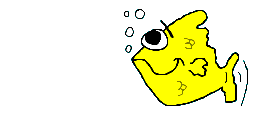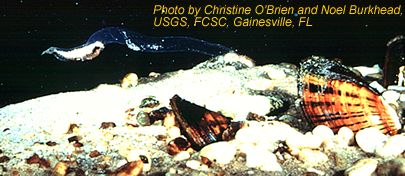![]()

A freshwater mussel goes through a life cycle similar to a moth. When the eggs develop inside of the mother freshwater mussel they are called glochidia (pronounced glow-kid-ee-ah) or larva. The glochidia are like a caterpillar that has to metamorphose (or change) into a moth. The glochidia must also go through metamorphosis to become a freshwater mussel. A caterpillar makes its cocoon on a leaf or branch, but a glochidium makes its cyst (or cocoon) on a fish. It is the job of the mother freshwater mussel to make sure the glochidia get close enough to a fish so they can make a cyst. To do this, the mother freshwater mussel waves part of her mantle (soft tissue that lines the inside of the shell) that looks like fish food. The fish see the mantle that looks like food and they come close to the mother and try to eat the mantle. When they are close enough, or take a bite of the mantle, the glochidia hook on to the fish and make a cyst. Fish eat all kinds of food; including bugs, worms, plants, and even other fish. Here are a few examples of mantles that look like a bug, plant, and a fish lure that acts like a fish.
|
This is a photo of the little spectaclecase mother attracting fish. If you were a fish wouldn't the mantle look like some kind of yummy bug or grub? |
This is a photo of the yellow sandshell mother attracting fish. Doesn't the mantle look like the a leaf or flower opening up?
|

This is a photo of a shinyrayed pocketbook mother attracting fish.
The shinyrayed pocketbook does not use a fancy mantle like the other freshwater mussel mothers. The shinyrayed pocketbook uses a fishing lure, like the one you would use to catch fish with, but this fishing lure is not real. This fishing lure has glochidia inside. The shinyrayed pocketbook makes a fishing line with a fish lure at the end. The water currents in the stream help to move the fish lure around so it looks like it is a real fish swimming. When a fish tries to eat the mantle or fish lure that looks like food, they get a mouth full of glochidia. The fish attempts to spit the glochidia out, but it is too late. The glochidia attach themselves to the fish and make a cyst, similar to a cocoon. The glochidia will ride around on the fish for a few days or even months. When the glochidia have gone through metamorphosis they will come out of the cyst as a little freshwater mussel. The little freshwater mussel will then fall to the bottom of the stream or lake and grow into an adult freshwater mussel.